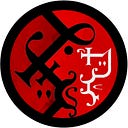The scribal arts
Material reality shapes the Mana Field, and magic is a way to invert this process, making the Mana shape reality instead.
To cast a spell, one has to weave the mana field in a specific configuration, a knot, and then infuse it with their life force, making it real. The knots are complicated and require precision, so any tool that preemptively fashions the Field to approximate the desired knot is welcome.
After the Collapse, the vast wisdom of the surviving divinities helped lay the ground for the magical arts. It’s clear that everything influences the Mana Field, and the beings gifted with the divine spark, like archdevils and archangels, could understand some of the counterintuitive connections between mana and reality.
Shapes, for example: a metal sphere twists the Mana Field differently than a pyramid of the same material. The same is true in two dimensions: a circle carved in stone elicits a different reaction than a triangle.
So, if you want to cast a spell to create a puddle of water, you have to make a specific knot. To make the process easier you can draw a series of geometric shapes that already weave the mana in an approximated shape.
This is the basis of the “scribal arts”, the sum of all the magic practices that focus on shapes as a tool. (Alchemic arts, by contrast, focus on materials and different substances).
Sings with “magical significance”, meaning symbols that twist the mana in an exploitable way, are divided by size and complexity:
- Glyphs are small and resemble weird letters;
- Sigils are usually as big as pages of books or portrait paintings, looking like elaborate diagrams;
- Circles occupy rugs or floors or even wider areas and can be dizzyingly intricate;
These categories are fuzzy and there is the added confusion that some prefer sorting by complexity and others by sight size.
Glyphs help a wizard to cast a specific spell, or “family of spells”, but it’s still just an “ingredient” of the incantation. Many wizards will wear rings, medallions, and other jewelry decorated with glyphs as a focus for their spell. Glyphs can interfere with each other so each magic user has to make a choice to what have on themselves. Every culture has its version of a glyphs’ encyclopedia, a staple in all wizards’ libraries.
Sigils can be seen as “half casted” spells, as they can take the place of a considerable part of the incantation. A wizard can just follow some instructions and “activate” the sigil, casting a spell they would otherwise not know how to perform.
Sigils are a way to explain spells, sell them, teach them, transport them. To use sigils, it is still necessary to have some proficiency in the magical arts, usually more than decent, since there is no shared standard in coding the instructions.
The complexity of Magical Circles is so much to supplant the need for incantations, sometimes entirely. This means that some magical circles are de facto magical objects, usable by everyone who knows the activation word or gesture. Magic needs Life Force to produce effects, so there is no circle working autonomously and indefinitely. As complexity grows, more and more variables have to be considered and for this reason, magic circles are static and “tuned” to a location, so as to incorporate environmental factors.
The material involved in the creation of a magical sign will have an effect on the shape of the sign itself: a sigil has to be written in a slightly different way based on the type of ink and support. Many will argue that the motion of the hand has an impact as well. This of course can be used to one advantage, with a specific combination of techniques and materials giving the best results with a specific kind of magic.
For example, magic signs regarding evocation, the field dealing with the creation of forces and matter, are best written on skin, be it parchment, leather, or the body (a reason why a lot of Erebus Evokers use body paint). Golden ink on black paper is an excellent choice for healing sigils, but black ink on a golden sheet won’t be as effective.
Magic signs are scalable, a glyph is small because, being simple, it doesn’t present problems to be written minutely.
But, for example, elvish calligraphers of the Sultanate would sometimes paint enormous glyphs, incorporating the gesture of writing as part of an incantation.
Gnomish Manicurists can write complex sigils on their fingernails (usually with the help of miniature golems), giving them elaborate spells at their fingertips, literally.
The sigil towns of the Angelic Unsion are a little of a misnomer: their roads and buildings constitute a magic circle creating subtle but continuous effects (it can be improved fertility, a slight warming effect, or some unconscious mind control).
Every culture has its specific way of incorporating glyphs, sigils, and circles to many uses. The shapes of the magic signs are found by trial and error, built on past experiences.
Recently there has been a general interest in the theory behind them, and various attempts to find out the laws of magic scribing. Dwarves scholars (mostly women) are at the vanguard of this research.
